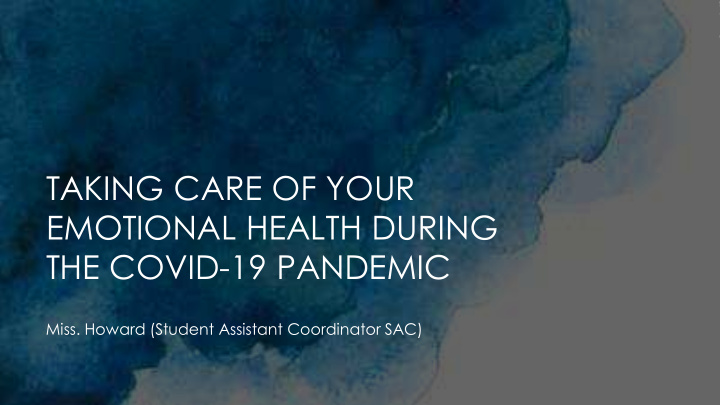



TAKING CARE OF YOUR EMOTIONAL HEALTH DURING THE COVID-19 PANDEMIC Miss. Howard (Student Assistant Coordinator SAC)
THE FOLLOWING INFORMATION WILL BE COVERED Recognizing stress during the COVID-19 Pandemic 1. Ways to manage your stress 2. Recognizing stress in your children, youth and students 3. Ways to help support your children, youth and students during 4. this time. Mindfulness Videos & Activities 5. Additional Resources 6.
FEAR AND WORRY ABOUT YOUR OWN HEALTH AND THE HEALTH OF YOUR LOVED ONES CHANGES IN SLEEP OR EATING PATTERNS DIFFICULTY SLEEPING OR CONCENTRATING WORSENING OF CHRONIC HEALTH PROBLEMS INCREASED USE OF ALCOHOL, TOBACCO, OR OTHER DRUGS CDC reports that stress during an infectious disease could look like… (Center for Disease Control, 2020)
Things you can do to support yourself Take breaks from watching, reading, or listening to news stories, including social media. Hearing about the pandemic repeatedly can be upsetting. Take care of your body. Take deep breaths, stretch, or meditate. Try to eat healthy, well-balanced meals, exercise regularly, get plenty of sleep, and avoid alcohol and drugs. Make time to unwind. Try to do some other activities you enjoy. Connect with others. Talk with people you trust about your concerns and how you are feeling. WAYS TO MANAGE YOUR STRESS (Center for Disease Control, 2020)
Excessive crying or irritation in younger children Returning to behaviors they have outgrown (for example, toileting accidents or bedwetting) Excessive worry or sadness Unhealthy eating or sleeping habits Irritability and “acting out” behaviors in teens Poor school performance or avoiding school Difficulty with attention and concentration Avoidance of activities enjoyed in the past Unexplained headaches or body pain Use of alcohol, tobacco, or other drugs ** Its important to understand that stress can/will look differently for each child** CDC STATES STRESS IN CHILDREN & TEENS COULD LOOK LIKE… (Center for Disease Control, 2020)
Take time to talk with your child or teen about the COVID-19 outbreak. Answer questions and share facts in a way that your child or teen can understand. Reassure their safety. Let them know it is ok if they feel upset. Share with them how you deal with your own stress so that they can learn how to cope from you. Limit your family’s exposure to news coverage & social media. Children may misinterpret what they hear and can be frightened about something they do not understand. Try to keep in place regular routines. Due to school closings create a schedule for learning activities and relaxing or fun activities. Be a role model. Take breaks, get plenty of sleep, exercise, and eat well. Connect with your friends and family members. WAYS TO HELP YOUR CHILD COPE (Center for Disease Control, 2020)
3 MINUTE MINDFULNESS BREATHING
Once you find your breath, go through the following steps to help ground yourself: 5: Acknowledge FIVE things you see around you... 4: Acknowledge FOUR things you can touch around you... 3: Acknowledge THREE things you hear... 2: Acknowledge TWO things you can smell... 1: Acknowledge ONE thing you can taste… **Make an effort to notice the little things you might not always pay attention to 5-4-3-2-1 GROUNDING TECHNIQUE (Smith, 2018)
PROGRESSIVE MUSCLE TECHNIQUES
1 . Breathe (Part I): Breathe with awareness. What does it feel like to breathe? 2. Breathe (Part II): “Breathing in I calm my body. Breathing out, I smile.” Thich Nhat Hanh 3. Five-Finger Gratitude: For each finger on your hand, identify one thing you are grateful for. 4. Stand and Stretch: Take a deep breath, and bring your arms above your head for a deep stretch. 5. Be the Sky: See your thoughts as birds flying through the expansive sky of your awareness. 6. Check Your Posture: How do you feel? How does it feel to sit or stand with dignity and wakefulness? 7. Practice Lovingkindness: ”May [I, a loved one, or someone else] be happy, healthy, safe, and loved.“ 8. Body Scan: Soften areas of tension and savor sensations of relaxation and ease. 9. Breathe, Part III: Breathe in for five seconds, breathe out for five seconds. 10. Mindful Listening: Close your eyes and notice the sounds around you. A MINDFUL MINUTE (Beach,2017)
If you, or someone you care about, are feeling overwhelmed with emotions like sadness, depression, or anxiety, or feel like you want to harm yourself or others call: 911 Substance Abuse and Mental Health Services Administration’s (SAMHSA’s) Disaster Distress Helpline: 1 -800-985-5990 text TalkWithUs to 66746. (TTY 1-800-846-8517) Suicide Prevention Hotline: 1-800-273-8255 toll free 24/7 Resources could also be found on our district/school Counseling Page https://www.cdc.gov/coronavirus/2019- ncov/prepare/managing-stress-anxiety.html ADDITIONAL RESOURCES
REFERENCES Beach, S. R. (n.d.). Meditate for an hour every day unless you are too busy. In that case meditate for two hours. Retrieved March 17, 2020, from https://leftbrainbuddha.com/mindful-minute-10-simple-ways- bring-peace-day/ Mental Health and Coping During COVID-19. (2020, March 6). Retrieved March 17, 2020, from https://www.cdc.gov/coronavirus/2019-ncov/prepare/managing- stress-anxiety.html Smith, S. (2018, April 10). 5-4-3-2-1 Coping Technique for Anxiety. Retrieved March 17, 2020, from https://www.urmc.rochester.edu/behavioral-health-partners/bhp- blog/april-2018/5-4-3-2-1-coping-technique-for-anxiety.aspx
Recommend
More recommend